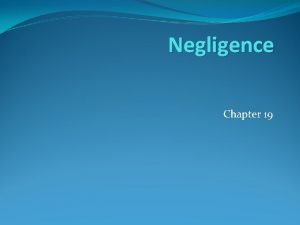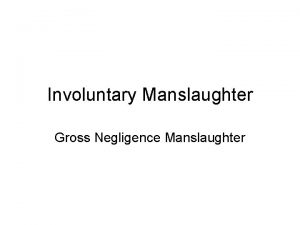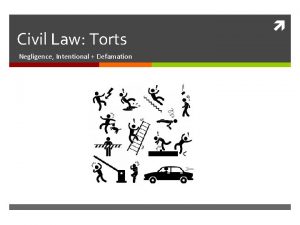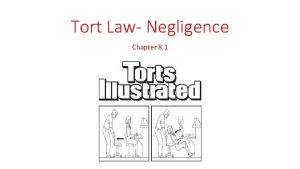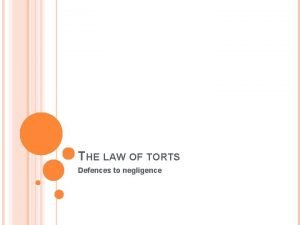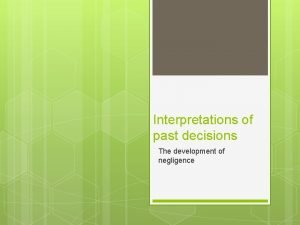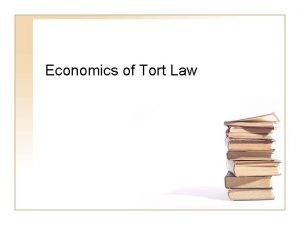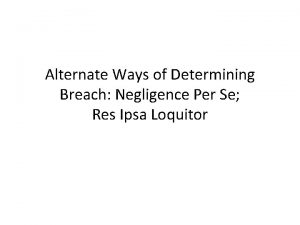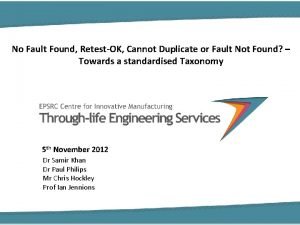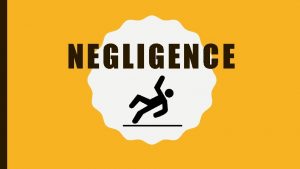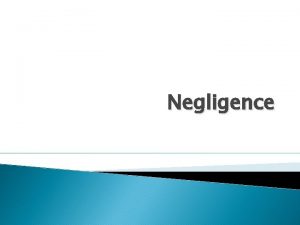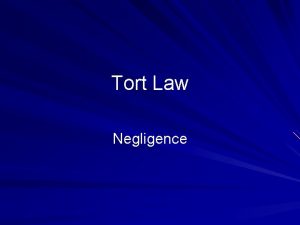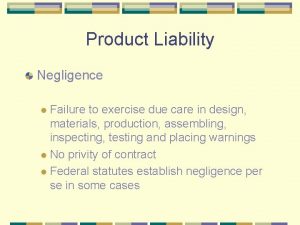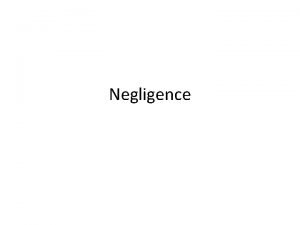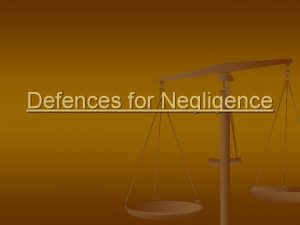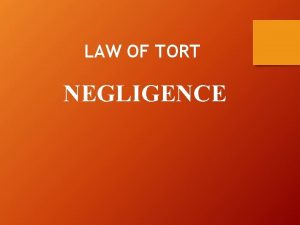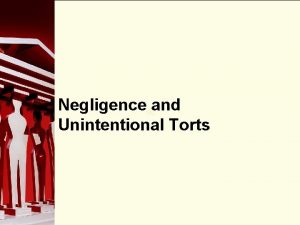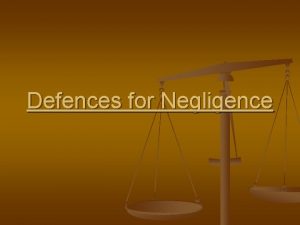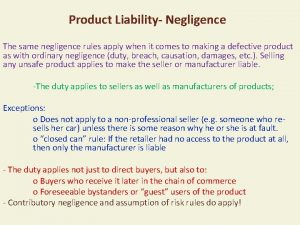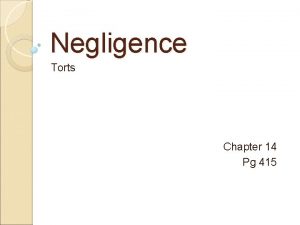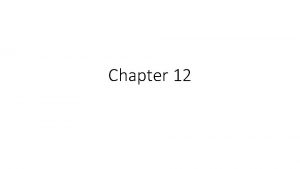Unit 31 Negligence Negligence failure to exercise the



















- Slides: 19

Unit 31 Negligence

Negligence § failure to exercise the care toward others which a reasonable or prudent person would do in the circumstances, or taking action which such a reasonable person would not The central factor in negligence is determining what the standard of care imposed on the public should be – a general rule: all persons have to conduct themselves in such a manner as not to create unreasonable risks of physical harm to others.

Two types of negligence a) Civil (minor personal injury and property damage) a) Criminal (results in death where there was no intention of injury)

Elements of negligence claim A) Duty of care (towards a plaintiff) B) Breach of duty (on the part of the defendant) C) Factual causation D) Damage (between the breach and the harm) (injury or harm as a consequence of the breach)

A) Duty of care n a person owes a duty of care to another when the reasonable person would foresee that the other will be exposed to the risk of injury n Eg. – a driver of a vehicle owes a duty to anyone within the area of risk when moving - other road users, pedestrians, the owner of adjacent land buildings

B) Breach of duty n unreasonable running a risk and harming to the others or their property

C) Factual causation o factual causation – a defendant is held liable if the particular acts or omissions were the cause of the loss or damage sustained (US – proximate cause) basic test of causation – to ask “but for, or without my breach of duty would you be harmed? ” – if NO – I am liable

D) Damage n provable injury – a precondition for successful negligence suits n Damage may be: a) Physical (personal injury) b) Economic (pure financial loss) c) Both (financial loss of earnings consequent on a personal injury) d) Reputational (in a defamation case) e) Emotional distress

Damages n a sum of money awarded by the court for harm suffered by the claimant

A hypothetical personal injury case: Don speeds through an intersection agains a red light and hits a vehicle driven by Pat, who had the green light and the right of way. Pat was injured. → A personal injury dispute based on negligence. 1. 2. 3. 4. What was the duty of care? How was the breach of duty caused? Describe the factual causation. . . What was the damage?

Essential expressions • act or omission • foreseeable harm/injury • a reasonable/prudent person • duty of care • breach of duty • factual causation/ proximate cause n n n a damage = an injury damages= compensation to commit negligence to award damages to breach duty to cause harm

Case law – tort of negligence n n Donoghue (or M’Alister) v Stevenson one of the most famous cases in British legal history The decision of the House of Lords founded the modern tort of negligence The case originated in Paisley, Renfrewshire under Scots law, but the House of Lords declared that the principles of their judgment also applied in English law. It is often referred to as the "Paisley snail" or the "snail in the bottle" case.

Judgement delivered by Lord Atkin 26 May 1932 - derived from the Christian principle of “loving your neighbour” in Luke 10 The rule that you are to love your neighbour becomes in law you must not injure your neighbour; and the lawyer's question: Who is my neighbour? receives a restricted reply. You must take reasonable care to avoid acts or omissions which you can reasonably foresee would be likely to injure your neighbour.

Explanation of the “neighbour” principle Who, then, in law, is my neighbour? The answer seems to be - persons who are so closely and directly affected by my act that I ought reasonably to have them in contemplation as being so affected when I am directing my mind to the acts or omissions that are called in question. . .

e. g. Consumption of products A manufacturer of products, which he sells in such a form as to show that he intends them to reach the ultimate consumer in the form in which they left him with no reasonable possibility of intermediate examination, and with knowledge that the absence of reasonable care in the preparation or putting up of products will result in an injury to the consumer's life or property, owes a duty to the consumer to take that reasonable care.

e. g. Medical Negligence Legally, medical professionals are accountable for their “duty of care” to prevent foreseeable harm, which can either be the result of an actual act or an omission that is to the detriment of the patient’s interests. Medical negligence is viewed as direct result of failing this duty, which is prosecutable for the injury it causes. a) Translate the above text into Croatian. b) Find at least one example of a medical negligence case in the UK.

Read the text, p. 142 – 143 and answer the following questions. 1. Describe the problems of the links between law as a system of rules and every day life experience. 2. Explain the opposites: reasonableness – negligence. 3. What does negligence rule mean from the perspective of judges and jurors? 4. Why and when was the notion reasonable man invented? 5. Who is “the man on the Clapham omnibus”? 6. How does a meticulously careful person behave?

Questions – PART 2 7. Describe the behaviour of ordinary people. Can it be connected to certain standards? 8. What is meant by the sentence “Wisdom consists in not exceeding the limit. ”? 9. Whose position should jurors use in their argumentation: the one of the reasonable man or the one of the impartial spectator? Explain. 10. Can the notion of “reasonable man” help in deciding cases after all? 11. What is the style of the text? 12. Which elements of the style do you recognise? 13. How do you evaluate the text structure?

n The Listener was a weekly magazine established by the BBC under Lord Reith in January 1929. It ceased publication in 1991. It was developed as a medium of record for the reproduction of broadcast talks. It also previewed major literary and musical broadcasts, reviewed new books, and printed a selected list of the more intellectual broadcasts for the coming week.
 Ventricular escape rhythm
Ventricular escape rhythm Failure to capture vs failure to sense
Failure to capture vs failure to sense Ductile fracture occurs due to
Ductile fracture occurs due to Conclusion for negligence
Conclusion for negligence Gross negligence manslaughter actus reus
Gross negligence manslaughter actus reus Elements of negligence
Elements of negligence Tort of negligence
Tort of negligence Volenti non fit injuria
Volenti non fit injuria Dr jekyll and mr hyde key quotes
Dr jekyll and mr hyde key quotes Negligence past tense
Negligence past tense Contributory negligence ppt
Contributory negligence ppt Negligence per se vs res ipsa loquitur
Negligence per se vs res ipsa loquitur Outdoor unit module protection error
Outdoor unit module protection error No faults found
No faults found Unit 10, unit 10 review tests, unit 10 general test
Unit 10, unit 10 review tests, unit 10 general test Hình ảnh bộ gõ cơ thể búng tay
Hình ảnh bộ gõ cơ thể búng tay Bổ thể
Bổ thể Tỉ lệ cơ thể trẻ em
Tỉ lệ cơ thể trẻ em Voi kéo gỗ như thế nào
Voi kéo gỗ như thế nào



